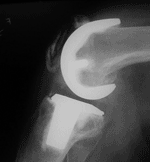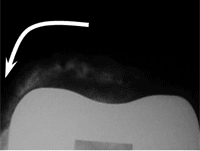Doing a lateral retinacular release during TKR may predispose the patella to failure
Omitting the release had no effect on patellar loosening, subluxation, dislocation rates in study.
Patellar issues, such as alignment and soft tissue balance of the patellofemoral joint, should be assessed long before surgeons begin total knee replacement surgery. But they may be able to improve their long-term success with these cases by not performing a lateral retinacular release intraoperatively, according to information presented at the 25th Annual Current Concepts in Joint Replacement Winter Meeting.
In a presentation he made at the meeting, Michael E. Berend, MD, of
Mooresville, Ind., discussed why the incidence of lateral retinacular release
is declining in association with modern total knee replacement (TKR) surgery.
He noted one reason
 is that
it may predispose the patella to loosening that could cause mid-term failure.
is that
it may predispose the patella to loosening that could cause mid-term failure.
“Patellar reconstruction starts with the femur and the tibia” rather than releasing the retinaculum across the board when faced with preoperative deformity of the patellofemoral joint, Berend said. “It is important to restore the pre-resection patellar thickness, correct the deformity and avoid a lateral retinacular release, if you can.”
|
Images: Berend ME |
More viable patella
Berend identified a high patella failure rate among the TKRs he analyzed that had a retinacular release. “In the knees found to eventually develop a loose patella, 73% had undergone a lateral release at the time of the primary TKR,” he told Orthopedics Today.
Avascularity may develop subsequent to the release, which could be the culprit when patellar failures occur following a TKR. Biological and biomechanical factors are associated with failure, Berend noted.
“Perhaps if you can avoid a lateral release, you may have better viability of the patella,” Berend said. Technical factors including the status of the lateral retinacular vessels appear less important. According to data he presented from another study from the Center for Hip and Knee Surgery examined 1,200 TKRs “found no difference in the subluxation, dislocation or long-term loosening or fracture in those knees that had the lateral geniculate artery saved and those that had it sacrificed.”
Another recommendation Berend made was using all-polyethylene patellar replacements rather than metal-backed components when possible during TKR.
Cement, polyethylene issues
Our long-term data indicate that all-polyethylene components tend to be more forgiving and amenable to patellofemoral balancing, Berend said. “Properly balancing the patellofemoral joint when implanting uncemented metal-backed patellar implants, I think, is probably more critical than with an all-polyethylene implants do to issues with edge loading failures,” he said.
Berend also suggested total knee surgeons reference the transepicondylar and AP axis and not the posterior condyles when placing femoral TKR components. He bases that suggestion on D.G. Newbern and colleagues’ research from the Center for Hip and Knee Surgery that identified a 57% lateral retinacular release rate with those cases where the condyles were referenced, vs. a 12% release rate when surgeons referenced the transepicondylar axis.
|
|
|
“If you put the femur on properly … you will naturally re-establish the patellofemoral articulation,” Berend explained in his presentation, showing an example where this approach was used effectively.
Often in valgus deformity and with preoperative patellofemoral contracture, these can be corrected intraoperatively by carefully identifying the rotation of axis in each knee. This allows for more accurate placement of the femoral component, which in turn can enhance overall patellar tracking, Berend said.
For more information:References:
- Michael E. Berend, MD, can be reached at the Center for Hip & Knee Surgery, 1199 Hadley Road, Mooresville, IN 46158; 317-831-2273; e-mail: mikeberend@hotmail.com. He is a consultant to and receives royalties for intellectual property rights with Biomet Orthopaedics.
- Berend ME. Improving patellar tracking: The retinacular release. #120. Presented at the 25th Annual Current Concepts in Joint Replacement Winter Meeting. Dec. 10-13, 2008. Orlando, Fla.
- Berend ME, Ritter MA, Keating EM, et al. The failure of all-polyethylene patellar tracking using the trans-epicondylar axis and the posterior condylar axis. Clin Orthop Relat Res. 2001;388:105-111.
- Newbern DG, Faris PM, Ritter MA, et al. A clinical comparison of patellar tracking using the transepicondylar axis and the posterior condylar axis. J Arthroplasty. 2006; 21(8):1141-1146.
- Ritter MA, Herbst SA, Keating, et al. Patellofemoral complications following total knee arthroplasty. Effect of a lateral release and sacrifice of the superior lateral geniculate artery. J Arthroplasty. 1996; 11(4): 368-372.



